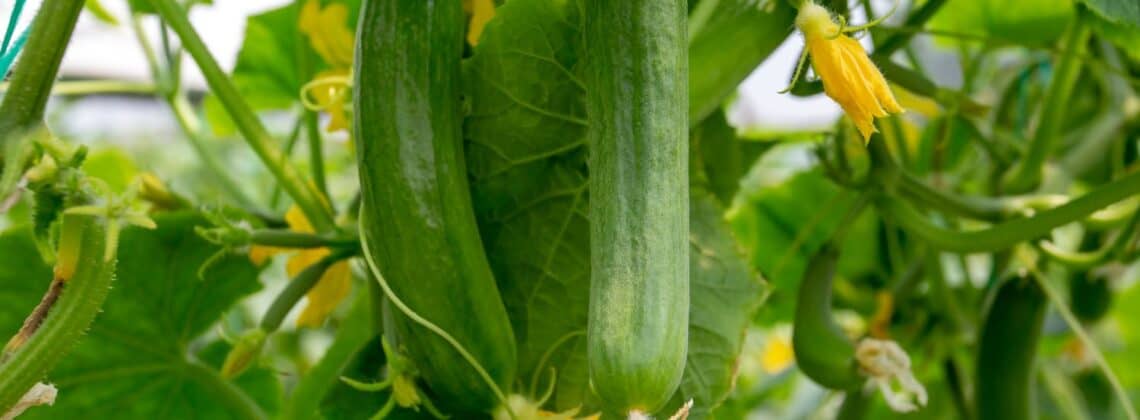
A comprehensive guide on how to grow cucumbers, maximize production with a vertical trellis, and identify and treat common cucumber diseases and problems.
Growing cucumbers (Cucumis sativus) in your backyard garden can be a rewarding experience. Cucumbers are a versatile vegetable, perfect for salads, pickling, and even eating fresh off the vine. That’s why cucumbers are a popular backyard vegetable.
This guide will walk you through everything you need to know about growing cucumbers, from planting to managing common diseases and pests.
Selecting the Right Cucumber Variety and Planting
Before you start, choose the cucumber variety that best suits your needs. There are two main types:
- Slicing Cucumbers: Best for fresh eating. Examples include Marketmore 76 and Straight Eight.
- Pickling Cucumbers: Smaller and ideal for pickling. Examples include Boston Pickling and National Pickling.
Site Selection for Planting Cucumbers
- Sunlight: Choose a spot that receives at least 6-8 hours of direct sunlight daily.
- Soil: Cucumbers prefer well-draining, fertile soil with a pH between 6.0 and 7.0.
- Spacing: Space seeds or seedlings 12-18 inches apart in rows that are 3-4 feet apart.
Planting Time
- Outdoor Planting: Cucumbers can be grown from seed or from starter plants that you buy from a local nursery or garden center. Plant cucumber starter plants or seeds outdoors after the last frost date when soil temperatures reach about 70°F (21°C).
- Indoor Starting: To get a jump start on your garden, you can start cucumber seeds indoors 3-4 weeks before the last frost date. Then, transplant them outdoors once the danger of frost has passed.
Planting Method
Many garden vegetables can be planted directly into garden soil or started as seeds for transplanting into the garden. Cucumbers grow well either way. So, the question about how to grow cucumbers comes down to your choice and your gardening situation. Here are your options:
- Direct Seeding: Plant seeds 1 inch deep directly into the garden soil. Buy cucumber seeds here.
- Transplanting: If starting indoors, plant seeds in starter pots or trays. Grow underneath lights to keep the seedlings from getting too tall and spindly. Keep the potting soil evenly moist. (Don’t let your seedlings get too dry!) When it’s time to plant seedlings in the garden outdoors, transplant seedlings carefully to avoid disturbing the roots.
Growing Cucumbers Vertically on a Trellis
Growing cucumbers vertically on a trellis is an excellent way to save space and improve plant health. Here’s how and why to grow your cucumbers on a trellis.
Benefits of Trellising
- Space Efficiency: Vertical growth maximizes garden space, making it ideal for small gardens.
- Improved Air Circulation: Better air flow around the plants reduces the risk of fungal diseases.
- Easier Harvesting: Fruits are easier to see and pick.
- Healthier Fruits: Keeps cucumbers off the ground, reducing the risk of rot and pest damage.

Choosing a Trellis
- Types: A-frame, teepee, or flat trellis against a fence or wall.
- Material: Use sturdy materials such as metal, wood, or strong plastic netting.
Installing the Trellis
- Placement: Position the trellis where it will receive maximum sunlight.
- Height: Ensure the trellis is tall enough to accommodate cucumber vines. A height of 5-6 feet is ideal. Of course, if you have a smaller garden choose a smaller trellis. The metal A-frame cucumber trellis from Gardeners Supply Company is a good choice.
- Support: Secure the trellis firmly in the ground to withstand wind and the weight of the plants.
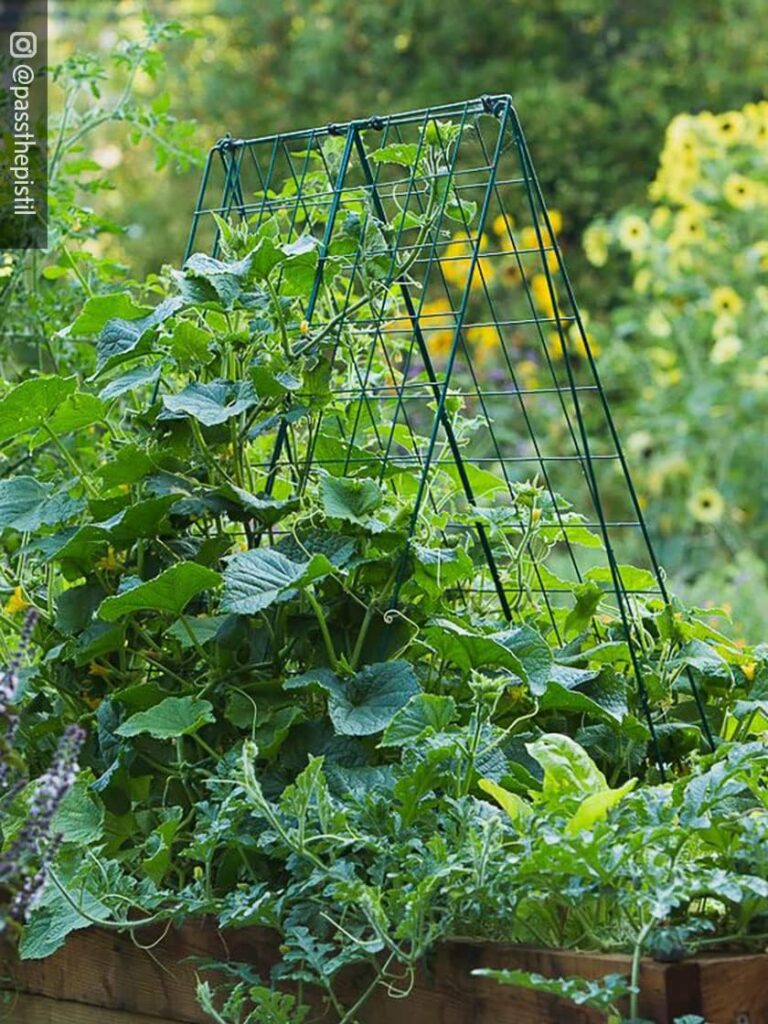
Training the Vines
- Guiding: As the cucumber vines grow, gently guide them towards the trellis.
- Tying: Use soft ties or plant clips to secure the vines to the trellis. Avoid tying too tightly to prevent damage to the vines.
- Pruning: Remove any lower leaves or side shoots that do not support fruit production to encourage vertical growth.
How to Grow Cucumbers: Care and Maintenance
All garden plants need care and attention throughout the garden season. Cucumber plants are easy to grow, but they need regular care and attention. Start by providing regular water, fertilizer, and mulching to get your cucumber plants off to a good start. Basic care will also help your plants stay healthy throughout the growing season.
Watering
- Consistent Moisture: Cucumbers need consistent moisture. Water deeply once or twice a week, providing about 1 inch of water each time.
- Avoid Waterlogging: Ensure the soil is well-drained to prevent root rot.
Watch for signs of water stress. Signs of not enough water include wilted leaves that become brown and die back. Signs of too much water include leaves that turn yellow. Also look for soggy soil that never dries out, which can cause root rot.
Fertilizing
- Pre-Planting: Incorporate compost or a balanced fertilizer (e.g., 10-10-10) into the soil before planting.
- During Growth: Side-dress with compost or a balanced fertilizer once or twice during the growing season.
Mulching
- Weed Control: Apply mulch around the plants to suppress weeds and retain soil moisture.
- Temperature Regulation: Mulch helps keep the soil temperature consistent.
Common Cucumber Plant Diseases and Treatments
Cucumber plants are easy to grow, but they can suffer from damage from a few plant diseases. The most common diseases to affect cucumbers are powdery mildew, downy mildew, and bacterial wilt.
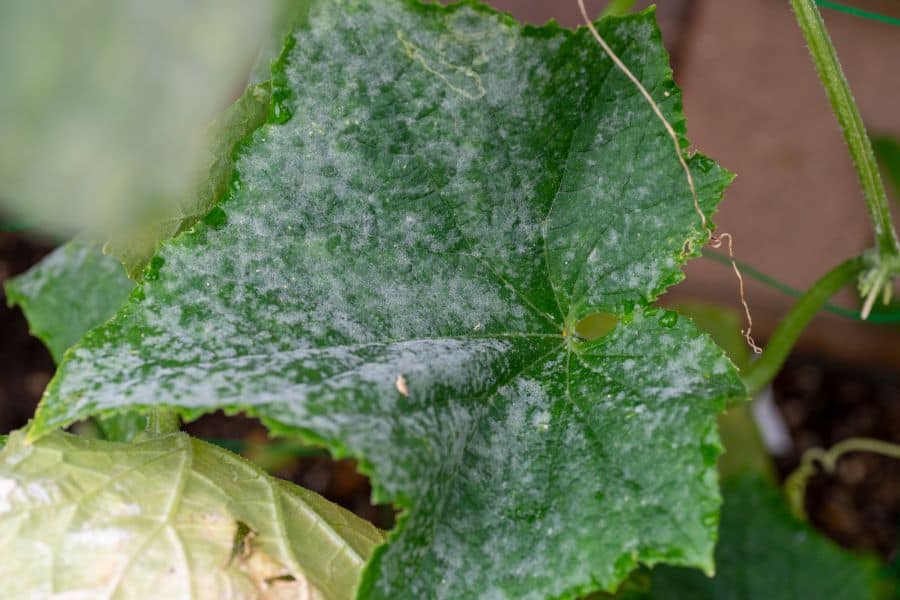
Powdery Mildew
- Identification: White, powdery spots on leaves, stems, and fruits.
- Treatment: Remove affected parts, increase air circulation, and apply fungicides like neem oil or sulfur.
Downy Mildew
- Identification: Yellow spots on the upper leaf surface and grayish-purple mold on the underside.
- Treatment: Remove and destroy infected leaves, improve air circulation, and use fungicides containing chlorothalonil or mancozeb.
Bacterial Wilt
- Identification: Leaves wilt during the day and recover at night, eventually leading to plant death.
- Treatment: Control cucumber beetles (the disease carriers) with row covers or insecticides like pyrethrin.
How to Grow Cucumbers: Insect Problems and Solutions
Cucumber plants can also suffer from damage by insect pests. These are three of the most common insect pests that can damage (and sometimes kill) cucumber plants.
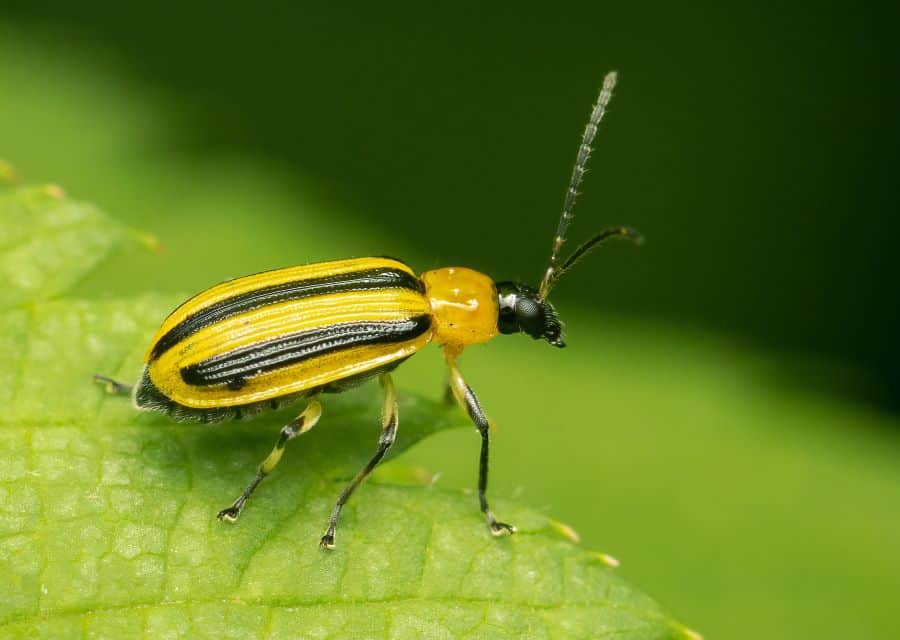
Major Insect Pests
- Cucumber Beetles (Striped and Spotted)
- Identification: Yellow-green beetles with black spots or stripes.
- Control: Use row covers to protect young plants, hand-pick beetles, and apply insecticidal soap or neem oil.
- Aphids
- Identification: Small, green or black insects on the undersides of leaves.
- Control: Spray with a strong stream of water, introduce beneficial insects like ladybugs, or use insecticidal soap.
- Spider Mites
- Identification: Tiny, red or yellow mites and fine webbing on leaves.
- Control: Spray with water to dislodge mites, use miticides, or introduce predatory mites.
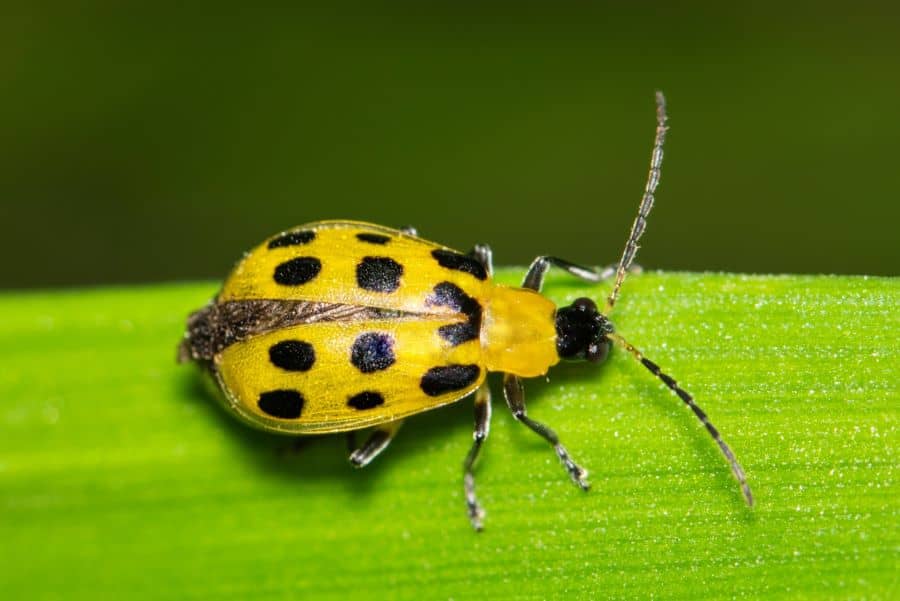
Harvesting and Storage of Cucumbers
Harvesting
- Timing: Harvest cucumbers when they are 6-8 inches long for slicing varieties, or 3-4 inches long for pickling varieties.
- Method: Cut the stem with a sharp knife or pruners to avoid damaging the plant.
Storage
- Short-Term: Store cucumbers in the refrigerator for up to a week.
- Long-Term: Pickle cucumbers for extended preservation.

Tips for Success
- Rotation: Practice crop rotation by not planting cucumbers or related plants (melons, squash) in the same spot each year to prevent soil-borne diseases.
- Regular Monitoring: Check your plants regularly for signs of pests and diseases to catch and address issues early.
By following these guidelines, you can enjoy a bountiful cucumber harvest and keep your plants healthy and productive throughout the growing season. You might also enjoy our story about how to Prevent and Treat Tomato Diseases. Happy gardening!
Home Garden and Homestead is a member of the Amazon Associates program and receives a commission generated by links in this story.




Leave a Reply